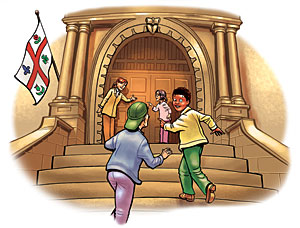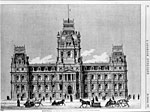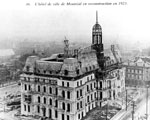

City hall

Many students do not know exactly what to expect when they hear the words “City Hall”. Perhaps they have heard about it on television but don’t really know what goes on there. City Hall is the seat of municipal authority. It is a kind of municipal palace, so it is not surprising that the students find it looks like a castle. It really is a prestigious building.
The elected municipal representatives sit here. The mayor, the president of city council and the members of the executive council all have their offices here. Other city services are also located here, such as the Section des archives, the Bureau du protocole et de l’accueil and an Accès Montréal office.
Citizens can visit the Hall of Honour during the week between 8 a.m. and 5 p.m. Sometimes exhibitions are held there. Guided tours of the Hall of Honour and the Council Room are also available.


Citizens of Tomorrow at City Hall
To get to the vestibule, take the stairway from Notre-Dame Street. A City Hall guide will greet you when you arrive. He or she will first take you to meet an archivist. Next comes a visit to the Hall of Honour, with its impressive chandelier and after that, the Council Room.
The Council Room is the meeting place for the municipal council, made up of the mayor and city councillors. The elected representatives debate city projects and vote on resolutions and regulations.




1. Postcard of City Hall before the fire of 1922. Centre d’histoire de Montréal.
2. City Hall, L’opinion publique, January 24, 1878.
3. City Hall being rebuilt following the 1922 fire. City of Montréal.
4. Postcard of City Hall after the fire of 1922. Centre d’histoire de Montréal.
Students will be able to sit in the representatives’ chairs. Perhaps a passion for politics will be ignited in one of our Citizens of Tomorrow … Or at least, these Citizens of Tomorrow will have the sense that municipal politics are accessible to them – in particular if your class gets to meet an elected representative. If this happens, you will be received in one of the protocol rooms. The children will be served a small snack and, most important of all, they will be able to sign the Golden Book. A photograph will immortalize the moment. And you will receive this photograph in your classroom. An unforgettable moment.
A bit of history…
The first mayors met in a series of buildings in Old Montréal, among them the Bonsecours Market, from 1852 to 1878. Still, as the city continued to grow, the elected representatives dreamed of a prestigious building. Well-known architects were engaged, Alexander Cowper Hutchison and Henri-Maurice Perrault, who were inspired by the City Hall in Paris. Construction of a City Hall was amply justified at the time by the astounding rate of growth of the city’s population, which led to increasing demands for municipal services. Jean-Louis Beaudry inaugurated this first City Hall in 1878.
Little remains of the first building: it was ravaged by fire in 1922. Only the stone walls were left. City Hall was rebuilt using the stone walls spared by the fire but a fourth floor was added and the central pavilion became a bell tower. Work was completed in 1926. Other renovations were carried out subsequently but the reconstructed building remains essentially the same today.
![]() Next - A walk in Old Montréal
Next - A walk in Old Montréal
